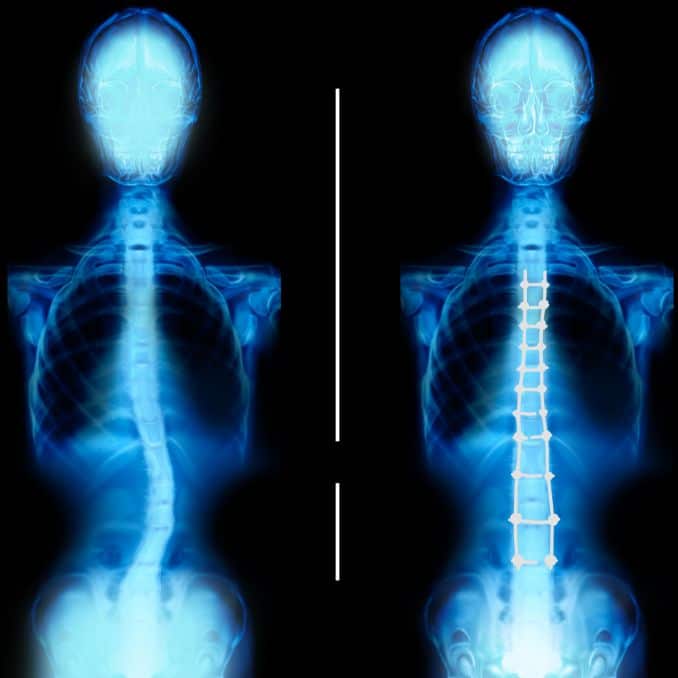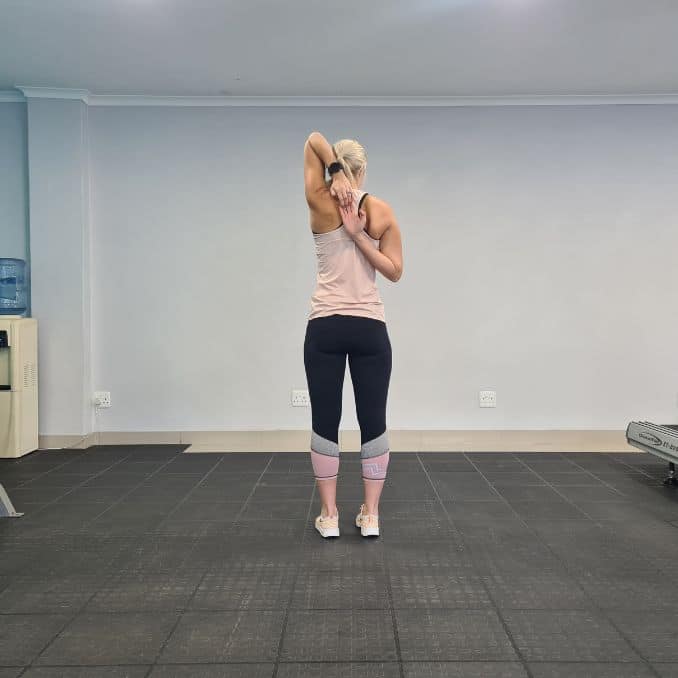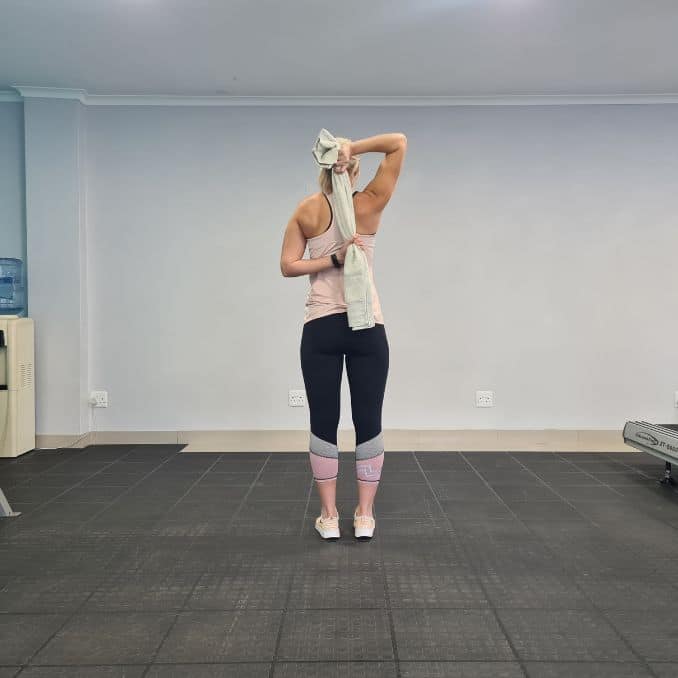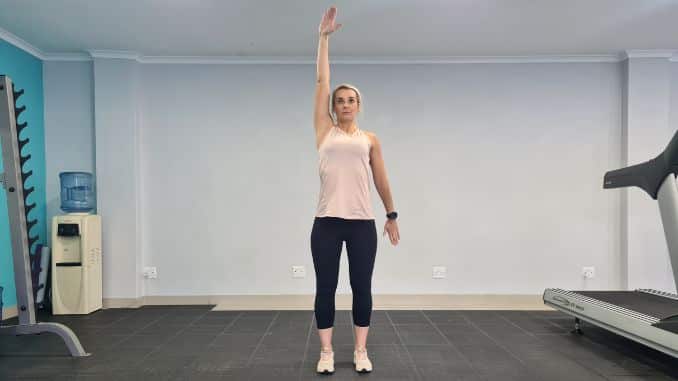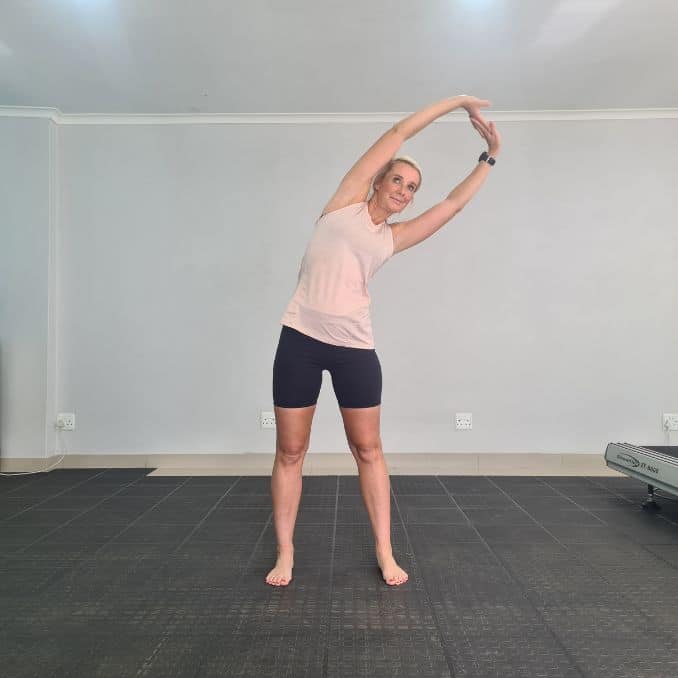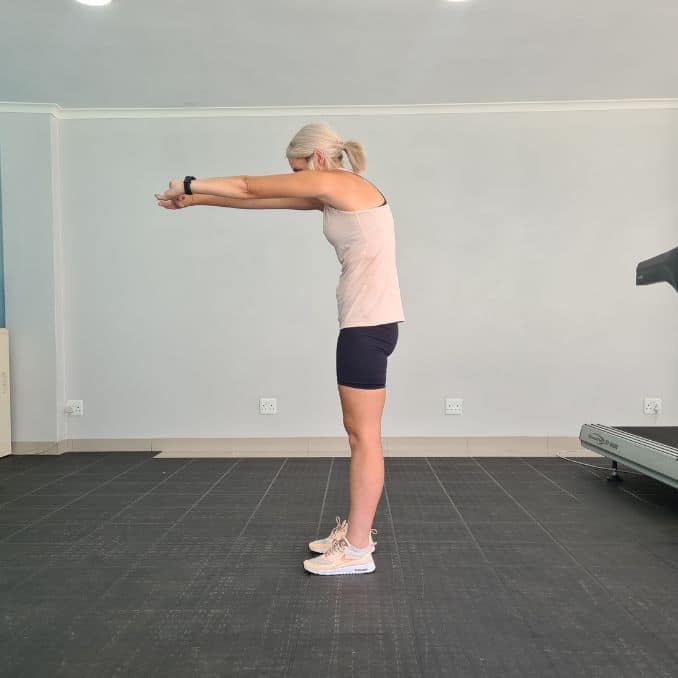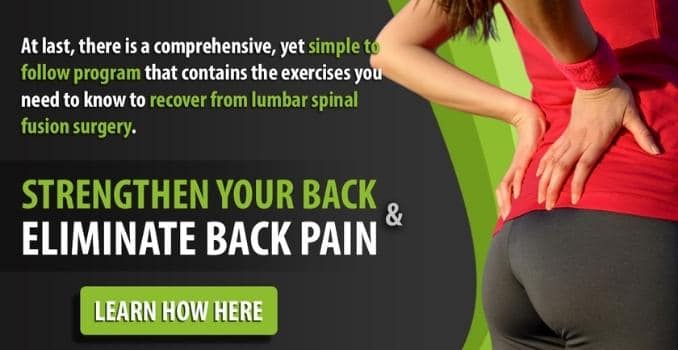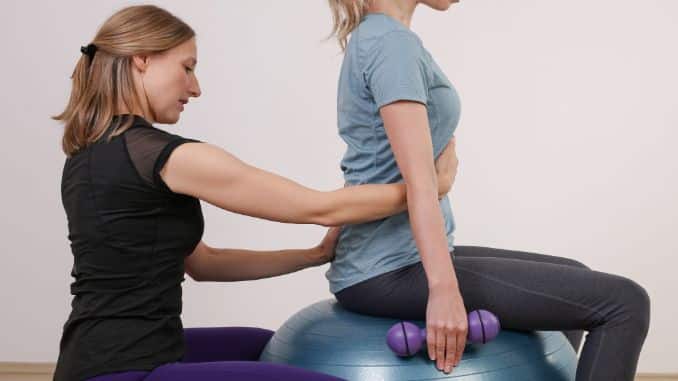
Treatment
Many classifications are used to determine the risk for progression and consequently the treatment of choice for each case of scoliosis. Scoliosis is a spine disorder in which the vertebrae gradually curve and rotate. It has been known to affect human beings since biblical times, but it was not identified as a medical condition until the mid-1700s.
Two Types of Treatment
There are two types of treatment and management of scoliosis which are: nonsurgical management and surgical treatment.
Nonoperative Treatment
A scoliosis curve will not correct itself and get straight. One of the common nonsurgical treatments such as Bracing prevents it from worsening. It is common in growing children for curves between 25 and 45 degrees to the progression of the curve while the growth of the spine remains.
The purpose of bracing is to prevent further progression but not to correct the curves. However, there has been advancement in Bracing. Corrective Bracing is said to achieve a curvature reduction by correcting the structural misalignment of the spine. The difference between them is holding the spine with traditional bracing or pushing to correct it and facilitating its ability to support itself. It has gone a long way but it still does not completely reverse the curvature.
Exercise is considered to be the most common non-invasive treatment approach when dealing with scoliosis. In general, exercise may not help in curve reduction. However, a specifically tailored fit scoliosis exercise plan, designed for the individual patient based on their condition is relevant.
Operative Treatment
Surgical intervention is indicated if an immature curved spine has a measurement of more than 45 degrees. Any curve measurement of more than 50 degrees seen in a mature spine is recommended for surgery. Generally, surgeries are indicated in cases where the progression of the curve significantly increases in spite of brace application, or if the person with scoliosis has been experiencing severe and intolerable back pain and respiratory complications. It is generally achieved by placing metal implants onto the spine that are then attached to rods, which correct the spine curvature and hold it in the corrected position until fusion, or knitting of the spine elements together.
Exercises
The role of exercise in controlling curve progression has been disputed by various researchers and experts. However, the beneficial effects of maintaining a regular scoliosis exercise regimen cannot be overlooked. Exercises mainly support and assist in the strengthening of the back, relieve pain and muscle tension, and maintain the efficiency of cardiopulmonary functions in people with severe scoliosis, improving their quality of life. Fitness professionals can play a key role in assisting clients with scoliosis with their exercise program.
Before starting any exercise program, it is very important that you understand the basics and the significance of correct body posture and body mechanics. The success of an exercise program is founded on these concepts. Improper postures and incorrect ways of moving around while we do our daily activities can affect the way we perform best scoliosis exercises and increase our risk of injuries. Make sure to observe proper posture and body mechanics when lifting, driving, sitting, and sleeping positions.
Warm-up and cool-down exercises are vital components of your exercise routine. It is advisable that before starting the exercise session you warm up for 5 to 10 minutes. It does not take a long time to do these exercises and when properly performed, they can greatly improve your muscle performance, resulting in more effective movements and better health outcomes.
One of the most recommended warm-up or cool-down exercises is walking. You can walk for the first 5 minutes and then try a few warm-up exercises mentioned in this section for another 5 minutes.
Here are some best scoliosis exercises you may consider:
1. Neck Rotations
Stand upright with your feet shoulder-width apart, maintaining proper alignment with your head, shoulders, hips, and legs. Here, you’re looking for a light stretch in your neck muscles, so rotate your neck to one side. Return to the starting position and repeat the movement on the opposite side.
Start with one set of 5 repetitions on each side. Perform the exercise in a smooth, controlled movement with a good stop at the end. The intensity is light. The purpose of this exercise is to work on the range of motion in the neck.
2. Sideway Neck Tilt
Stand upright with your feet shoulder-width apart, maintaining proper alignment with your head, shoulders, hips, and legs. Here, you’re looking for a light stretch in your sternocleidomastoid muscle, so rotate your head slightly to one side and lean your neck back gently. Hold this position for 10 seconds. Return to the starting position and repeat the movement on the opposite side.
Start with one set of 2 repetitions on each side, holding for 10 seconds. Perform the exercise in a smooth, controlled movement with a good hold at the end. The intensity is light. The purpose of this exercise is to work on statically stretching the sternocleidomastoid muscle.
3. Chin Tuck
 |
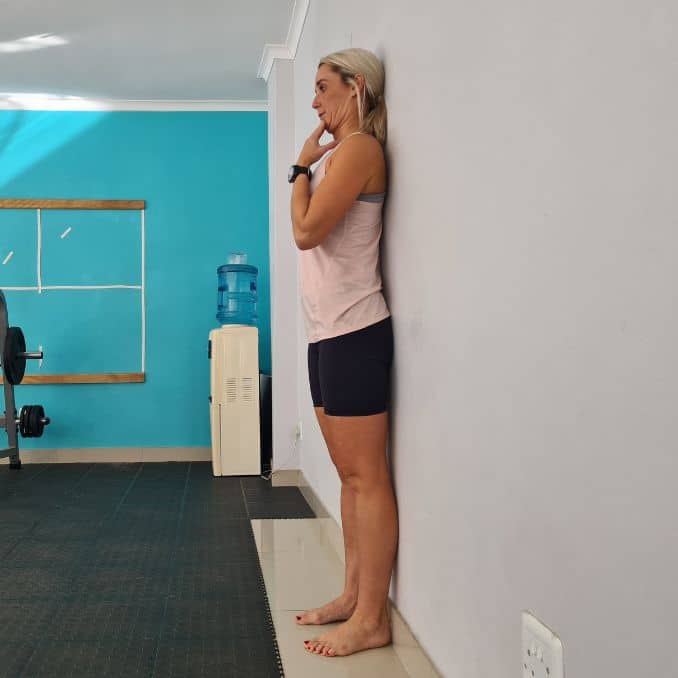 |
Begin in an upright standing position with your head, shoulders, hips, and legs in proper alignment. Slowly bring the chin down and back to elongate and bring the whole head back. Hold the position for 5 seconds. Return to the starting position and repeat the movement.
Start with one set of 5 repetitions, holding for 5 seconds. Perform the exercise in a smooth, controlled movement with a good stop at the end. The intensity is light. The purpose of this exercise is to improve the movement of the neck and vertebrae in the neck.
4. Head Tilt
 |
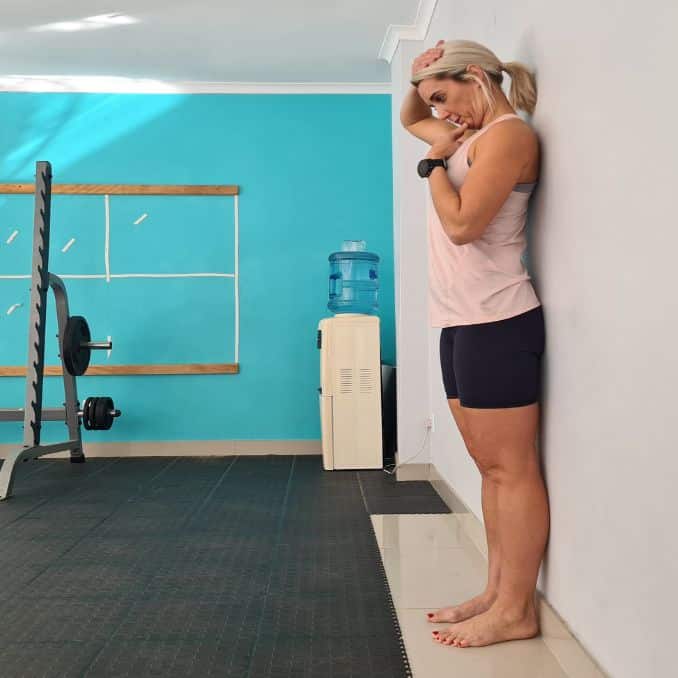 |
Begin in an upright standing position with your head, shoulders, hips, and legs in proper alignment. Drop your chin slowly toward your chest bone and hold the position for 5 seconds. Return to the starting position and repeat the movement.
Start with one set of 2 repetitions, holding for 5 seconds. Perform the exercise in a smooth, controlled movement with a good hold at the end. The intensity is light. The purpose of this exercise is to stretch the top part of the neck.
5. Shoulder Shrug
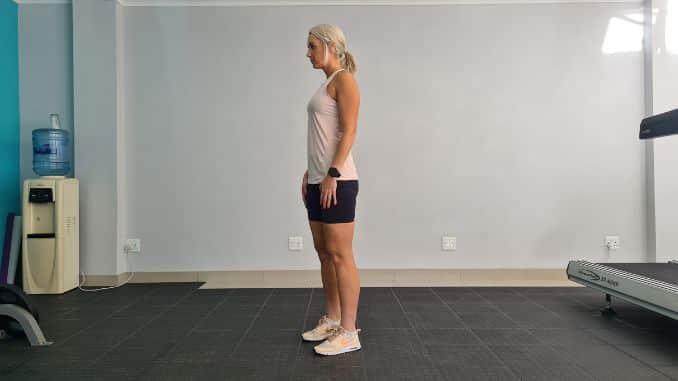 |
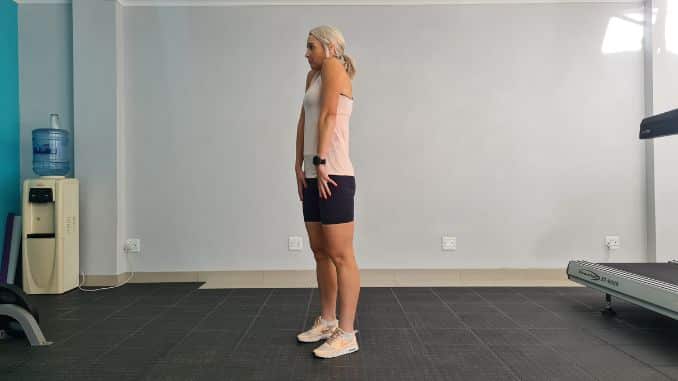 |
 |
In a standing position, bring the shoulders up, then roll the shoulders back and come back to start.
In this exercise, we are shrugging up to activate the upper trapezius and rolling back to activate the mid-back muscles. This aims to puts the shoulder in a good position, which helps to alleviate shoulder pain and activate the muscles that were not working properly.
Perform one set of 5 reps in a smooth, controlled movement with a good contraction at the top and middle of the movement. Intensity should be light and you are looking for a good contraction in the upper trapezius and the muscles in between the shoulder blades.
6. Figure-8 Stretch
This stretch involves trying to touch the fingertips together, gripping the fingers, and then pulling the hands closer together, stretching out the top and bottom shoulder.
Modified Stretch:
Many people will not have as much flexibility, so what you can do is utilize a towel. Grab a towel, starting at the top arm, and use the bottom arm to pull down. This will stretch out the top shoulder. Then, switch by having the top arm pull the bottom arm up and get that stretch in the bottom shoulder.
This exercise is more of a stretch in the shoulder to improve the flexibility of the shoulder.
Perform one set of 2 to 3 repetitions, holding the stretch for 5 seconds, then progress to 10 seconds with light intensity.
7. Laced Fingers and Arms Overhead
Interlace your fingers in front of you and raise your arms overhead, holding for a second or two. We are working on the muscles around the shoulder blades. Weak muscles in the neck and shoulders are weak will lead to poor activation, endurance, and strength. So, we are working on improving activation, endurance, and strength with this exercise.
Perform one set of 5 repetitions, holding the end position for a second or two.
8. Isometric Abdominal Exercise
The exercise Increases abdominal and core muscle strength. Sit tall with your back properly supported. Contract the abdominal muscles. Position the hands on the abdomen and press against the abdominal muscles. Resist the pressure. Hold for a count of 10.
Note: Breathe normally as you press against the abdominal muscles.
9. Brugger’s Postural Exercise
It corrects habitual slouching position, expands the chest, improves breathing, maintains the normal curvature of the spine, stretches the anterior side of the shoulder (latissimus dorsi, pectoralis major), strengthens mid-back (rhomboids), and promotes thoracic spine mobility.
Sit on a chair, back straight, feet hip-width apart. Increase the curve of the lower back by protruding your stomach. Lift the chest, squeeze the shoulders together, and relax the head and arms back.
Note: Your shoulder blades should move down and inward.
Hold for a count of 5 to 10. Release and repeat the exercise 5 times.
10. Pelvic Tilt
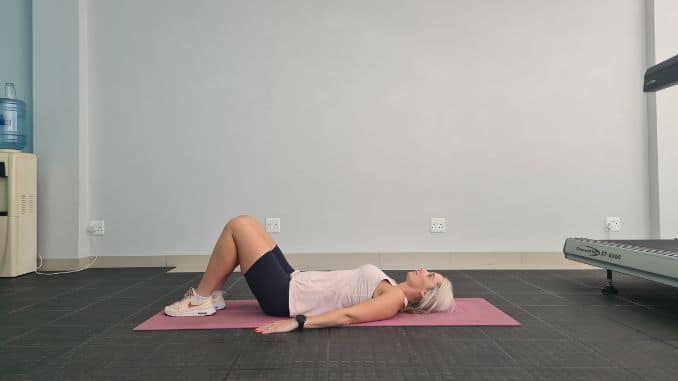 |
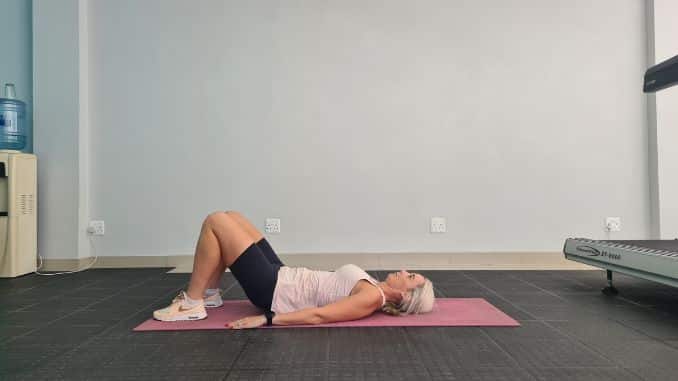 |
Lying on back with knees bent and feet flat on the floor. Flatten back by tightening stomach muscles and buttocks. Hold for 5 seconds, breathing normally. Repeat ten (10) times per set. Do two (2) sets per session? Do one (1) session per day.
11. Wall Series Lying Down
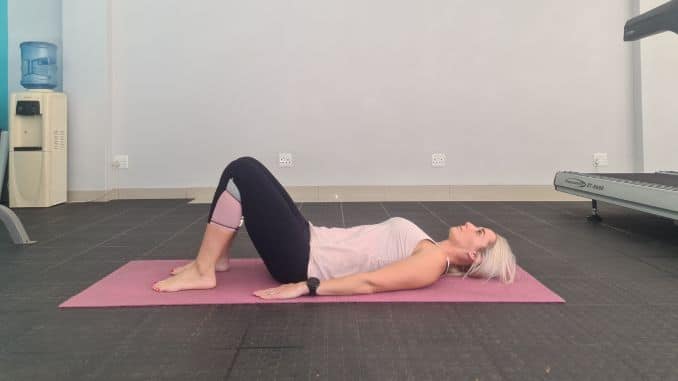 |
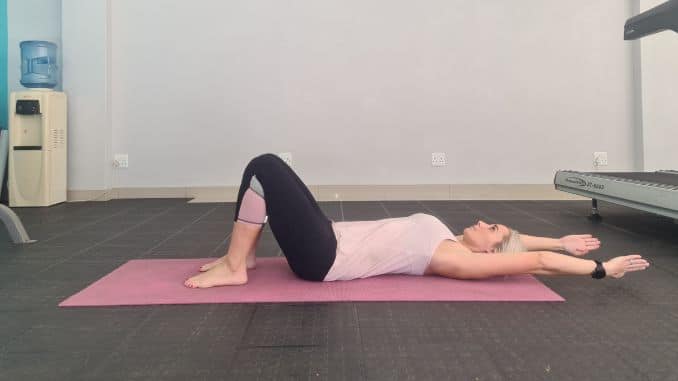 |
The routine strengthens the upper back (scapular stabilizers and rhomboids) and abdominal muscles, decreases the rounding of the upper back, and stretches outside of the mid and lower back (latissimus dorsi and erector spinae).
Lie on your back, knees bent, feet apart on the floor, arms at the sides. Raise the arms overhead, tightening the abdominal muscles and firmly pushing the upper back into the floor. Slowly return to the starting position. Repeat 5 to 10 times.
Note: Maintain deep breathing as you do this exercise.
Inhale into the sides of your ribs and upper back as you raise your arms overhead. Exhale as you return the arms to the start position.
12. Stretch Up and Reach Down
Stretches and reduces tightness in the spine.
Stand tall maintaining back alignment with the neck and hips, feet hip-width apart. Raise one arm toward the ceiling, lifting it straight up. The other hand reaches down toward the floor. Hold for a count of 20. Repeat the best scoliosis exercises 2 times.
Note: This exercise can be performed 3 times a day.
13. Lateral Flexion
It focuses on stretching the tight low back muscles. Stand tall with your hands raised overhead, feet shoulder-width apart. Clasp the hands together and bend to one side. Initially bend to the side of the spine’s convexity, the area that is opposite the back tightness. This allows the shortened muscles from the side of concavity to lengthen and release tension.
Hold for a count of 20. Return to a neutral position. Bend to the other side. Repeat the best scoliosis exercises 2 times.
14. Back Stretch
It stretches muscles in the upper back. Stand tall, feet slightly apart, toes pointing forward, knees slightly bent, and shoulders relaxed. Extend both arms forward at shoulder level. Clasp the hands with your palms facing the body. Gently pull your body away from the hands, slightly rounding the upper back. Hold for a count of 20. Perform the best scoliosis exercises 2 times.
15. Head to Knee Stretch
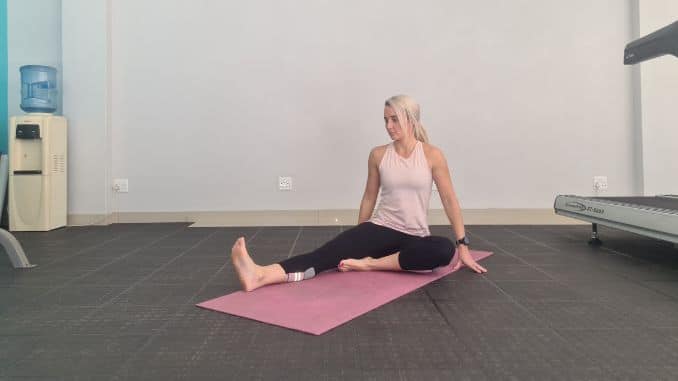 |
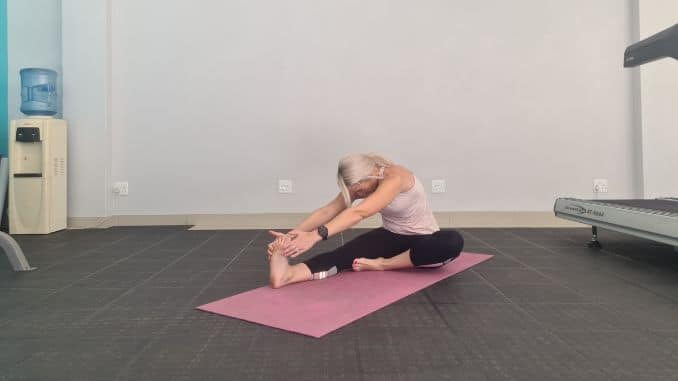 |
Stretches hamstrings (back of thigh), buttocks, and lower back. Keep your body relaxed and sit with both legs extended in front of you. Extend the right leg off to the side at about 40 degrees. Slowly bend the left leg and rest the left heel as far as you can in the upper inner right thigh, from the knee to the groin. Turn your torso toward the right leg. Inhale and slowly put your arms up over your head and exhale as you lean forward. It is important to keep the right leg straight.
The goal of these best scoliosis exercises is to feel a stretch, not see how far forward you can go.
Place your hands flat on the floor, on your calf, or if you can reach your foot. If you can’t reach it, use a strap to hold on to. Take deep breaths as you stay in this position for 20 seconds. Move out of the position by extending both legs and repeat the best scoliosis exercises on the other side. Perform twice on each side.
16. Side of Hip Stretch
 |
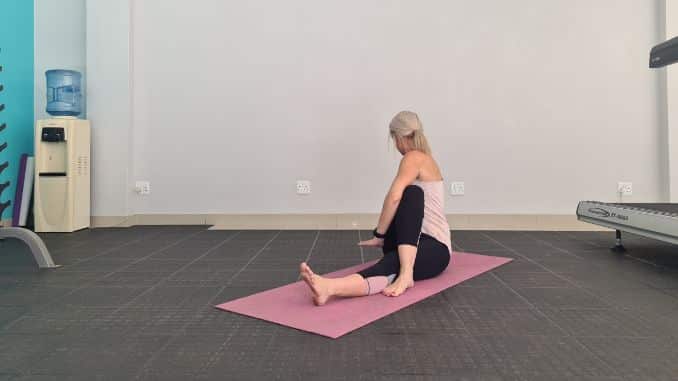 |
It stretches the muscles of the trunk, hip, and buttocks. Sit on the floor with both legs extended. Bend the right leg, cross it over, and place it outside the left knee. Bend the left elbow and place it outside the right knee.
Place the right hand behind the hips, with the palm on the floor. Turn the head towards the right shoulder, rotating the upper body. Hold for a count of 20. Release and repeat on the other side.
Takeaway
When Treatment is designed and applied correctly, scoliosis-specific therapy can help us address the rigidity in the spine that scoliosis is known to cause. Best scoliosis exercises can also help in addressing this and increase flexibility, the spine is more workable and responsive to treatment.
Activities that strengthen and stretch the back are key to successfully managing scoliosis and its symptoms. Choose something you enjoy and are likely to be able to stick with.

